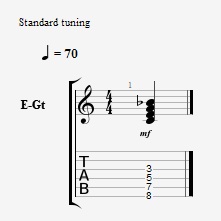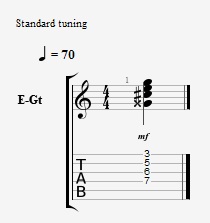Dominant Jazz Blues Chords
 Seventh chords and triads are used in various styles of music, but the most notable usage of them comes from jazz and blues.
Seventh chords and triads are used in various styles of music, but the most notable usage of them comes from jazz and blues.
Today we will discuss how to create dominant jazz blues chords. But before we get into playing dominant chords, it is important that you understand exactly what a dominant chord is, as playing is useless without understanding.
Each musical scale is comprised of seven different notes. Each note has a single name, except for the root note, which has two names. To play a dominant chord, you simply lower the seventh note of the scale (the leading tone) a half step. Keep in mind that dominant chords are primarily major chords!
Sounds Simple Right?
Today we are going to demonstrate two dominant seventh chords and walk you through how to build them. Assuming you already know how to build a seventh chord (if not refer to our lesson on seventh chords), making a dominant seventh chord should actually be the easiest thing in your life. Lowering the note value a half step is almost the simplest way to create a new chord out of a preexisting chord.
Getting Started With the Most Basic Scale
First off, as with all examples, we will use C Major to demonstrate as it is the only major scale that contains no accidental notes.
A first degree C Major seventh chord built on the tonic is comprised of the notes C, E, G and B.
To make this C Major seventh chord a dominant chord we simply take our leading tone, the note B, and bring it back a half step to create Bb.
Simple as that!
Our C Major dominant chord, when played in the first inversion should look something like this.

Download the .gtp file for the lesson ( Right click and Save As… )
Keep in mind that there are various positions on the neck where you can play this exact chord. As long as the notes are exactly the same, the chord will still be a C Major dominant seventh chord.
Next Up We Will Create an A Major Dominant Seventh Chord
This dominant jazz blues chord has a very pleasant quality to it. To make our dominant seventh chord we need to first get our first scale degree seventh chord. The tonic of A Major is A, and the A Major seventh chord in the first inversion is A, C#, E, G#.
To make this seventh chord a dominant seventh chord we simply take our seventh, G#, and move it down a half step. This leaves us with A, C#, E, G.
When transferring the notes to your fretboard, your chord shape should look like this:

Download the .gtp file for the lesson ( Right click and Save As… )
As long as you play the same notes, all of the dominant seventh chords are movable.
Now that you know how to create dominant jazz blues chords, the next step is to try them yourself. With the remaining Major keys, try to see if you can figure out the remaining dominant seventh chords.
If you begin over thinking the process, force yourself to relax and remember that all you do to the preexisting seventh chord I move the leading tone back a half step. With this in mind, try incorporating these flavorful chords into your own jazz and blues guitar playing. Not only will they add extra texture, but they can be used to transfer between chords. Have fun!
Intuitive Lessons For Guitar Players of All Levels

Jamplay is the BEST online guitar lesson website that offers step-by-step videos in hi-def resolution. They cover EVERY genre of guitar style and have comprehensive content for guitarists of any level of skill.
Jamplay also showcases a growing archive of video lessons that is updated regularly. What’s more, they also offer detailed tutorials for members to learn well known songs with the help of precise, dynamic tabs and song visualizations.
p.s: We have negotiated a wonderful deal for our readers. Get your exclusive Jamplay coupon code here…






Leave A Comment